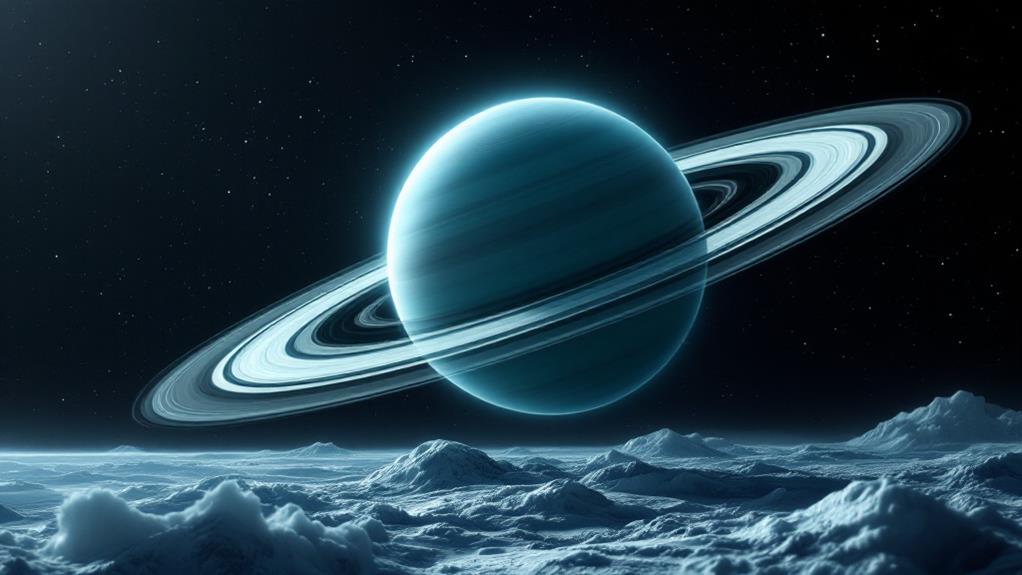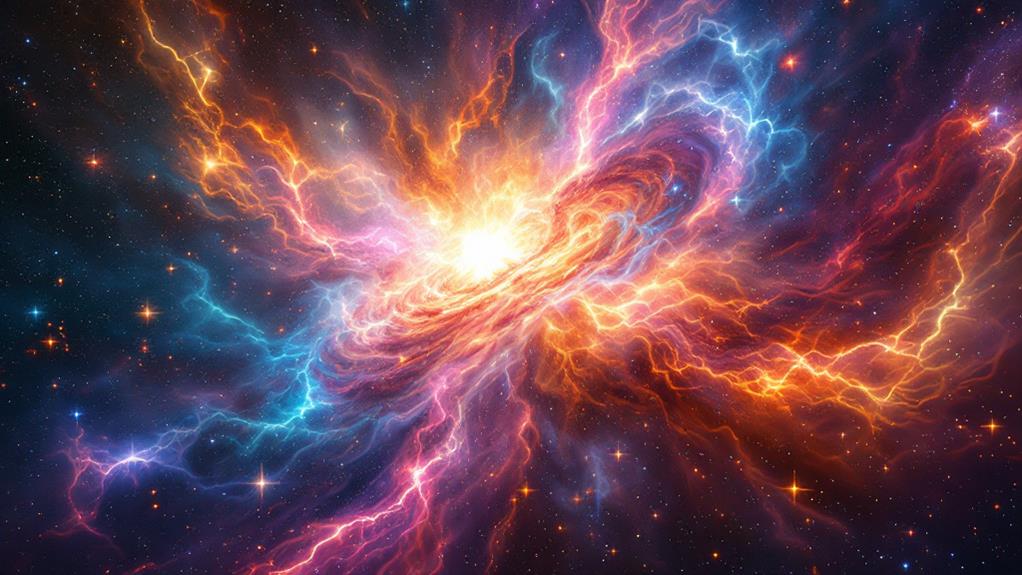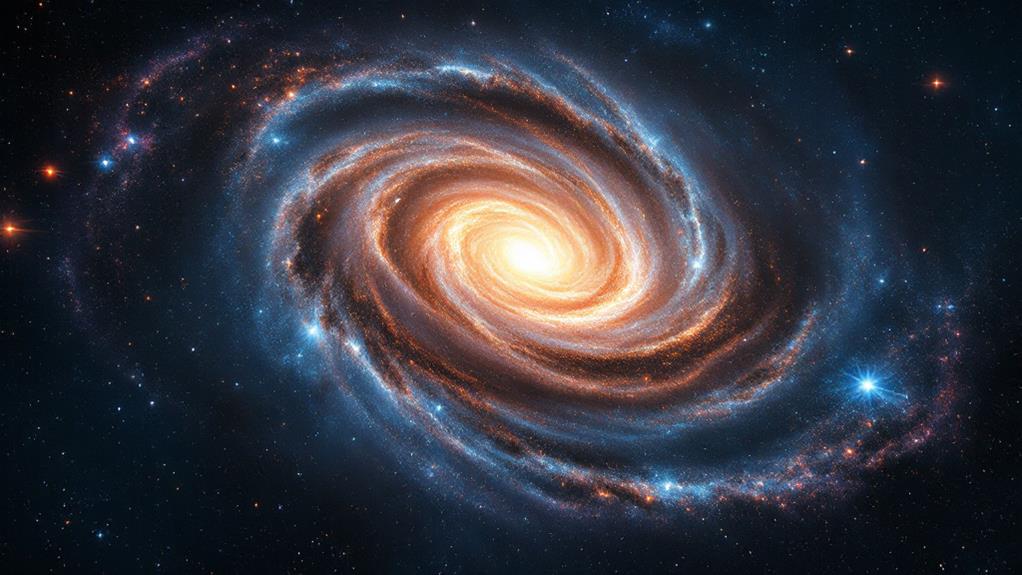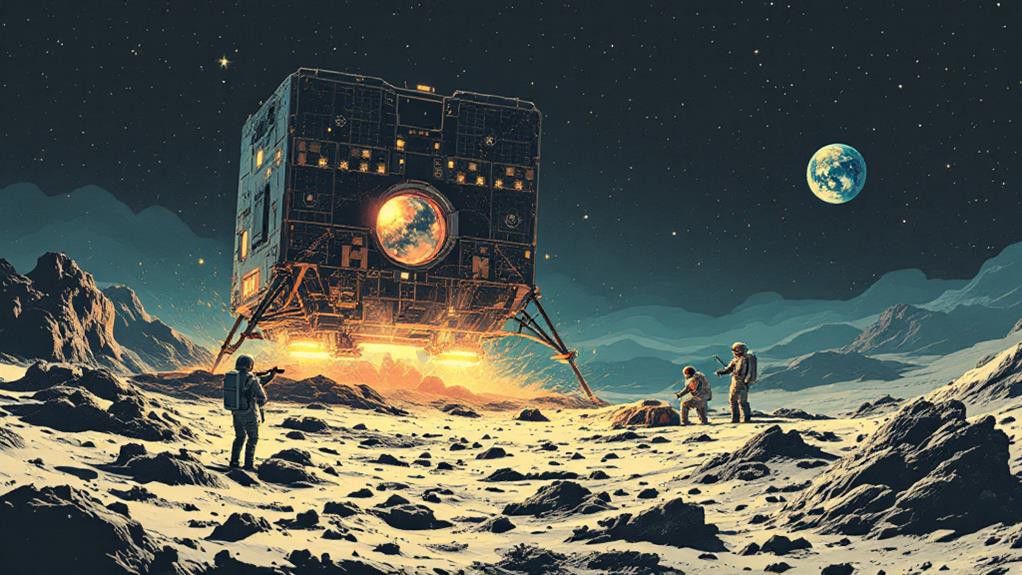Interesting Facts About the Other Moons in the Solar System: Beyond Earth’s Moon
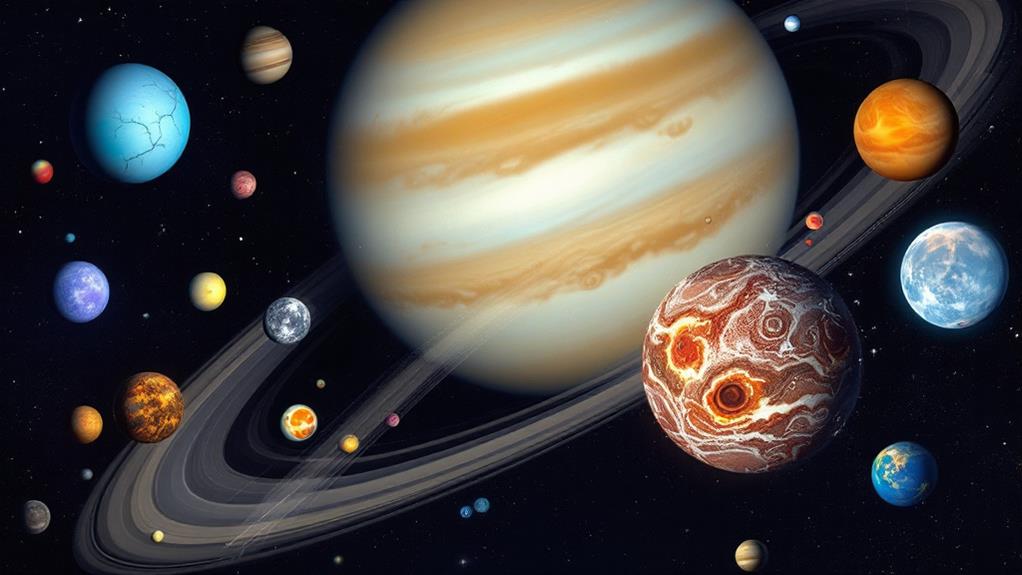
Beyond Earth's moon, you'll find a cosmic playground of fascinating lunar worlds. Jupiter's Io boasts over 400 active volcanoes, while Europa hides a vast ocean beneath its icy surface. Saturn's Titan features Earth-like weather patterns and methane lakes, and Enceladus shoots icy plumes into space. Ganymede, larger than Mercury, has its own magnetic field. Neptune's Triton orbits backwards, and Pluto's Charon is so massive they orbit each other. You'll uncover moons with patchwork terrains, potential alien habitats, and even one spiraling towards its doom. There's a universe of wonder waiting in our cosmic backyard.
Jupiter's Volcanic Moon: Io
Intensity defines Jupiter's moon Io, the most volcanically active body in our solar system. You'll find this celestial inferno locked in a constant state of eruption, with over 400 active volcanoes dotting its surface. These volcanic eruptions are so powerful that they can spew material up to 300 miles into space, creating a temporary atmosphere that quickly dissipates.
The secret behind Io's fiery nature lies in tidal heating. As Io orbits Jupiter, it's caught in a gravitational tug-of-war between the gas giant and its neighboring moons. This causes Io's interior to flex and stretch, generating immense heat that fuels its volcanic activity. The result is a hellish landscape of lava lakes, towering mountains, and sulfurous plains.
Io's surface is constantly remodeled by its volcanic activity, making it one of the youngest-looking moons in our solar system. You'd be hard-pressed to find impact craters here, as they're quickly buried under fresh lava flows. The moon's vivid yellows, reds, and whites are a reflection of its sulfur-rich composition, creating a mesmerizing yet deadly spectacle in Jupiter's orbit.
Europa's Hidden Ocean
Beneath Europa's icy surface lies a tantalizing secret: a vast, liquid water ocean. This Jovian moon's icy crust, estimated to be 10 to 30 kilometers thick, conceals a subsurface ocean that may be up to 60 miles deep. Scientists believe this hidden sea contains more water than all of Earth's oceans combined.
Europa's ocean remains liquid due to tidal heating, a process caused by Jupiter's immense gravitational pull. As the moon orbits the gas giant, it experiences constant stretching and squeezing, generating internal friction and heat. This energy keeps the water from freezing solid, despite the moon's frigid surface temperatures.
You might wonder about the potential for life in this alien ocean. The presence of liquid water, essential elements, and energy from tidal heating make Europa a prime candidate for harboring extraterrestrial life. NASA's upcoming Europa Clipper mission aims to study the moon's habitability and search for biosignatures. As you contemplate the mysteries of our solar system, remember that one of its most intriguing environments lies hidden beneath the icy shell of this distant Jovian moon.
Titan's Earth-like Features
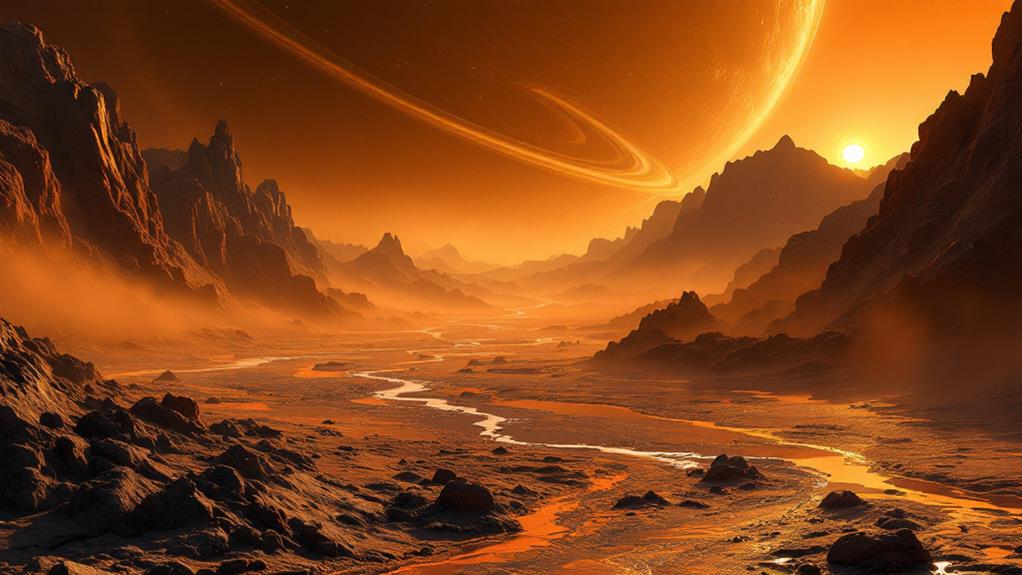
Saturn's largest moon, Titan, boasts an array of Earth-like features that make it a fascinating subject for planetary scientists. You'll find a thick atmosphere, weather patterns, and a hydrological cycle similar to Earth's, but with a twist. Instead of water, Titan's cycle revolves around methane.
On Titan's surface, you'll uncover methane lakes, rivers, and seas. These liquid hydrocarbons create a terrain eerily reminiscent of Earth's, complete with shorelines and islands. The moon's atmospheric haze, composed of complex organic molecules, gives it a distinctive orange glow and obscures the surface from view.
Titan's atmosphere is primarily nitrogen, just like Earth's, but it's much denser. This dense atmosphere allows for the possibility of rain and wind erosion, shaping the moon's landscape. You'd also find dunes made of hydrocarbon particles, resembling Earth's sand dunes.
The similarities don't end there. Titan experiences seasonal changes, with its methane cycle intensifying during summer months. These Earth-like features make Titan a prime candidate for studying potential habitability and the conditions necessary for life to evolve in our solar system.
Enceladus and Its Icy Plumes
Another of Saturn's moons, Enceladus, has enthralled scientists with its spectacular icy plumes. These plumes, erupting from the moon's south polar region, are a testament to the moon's cryovolcanism activity. As you might imagine, this icy world is far from dormant.
When you look at Enceladus, you'll notice its bright, reflective surface. But it's what's beneath that's truly mesmerizing. The plumes are composed of water vapor, ice particles, and various organic compounds. This plume composition hints at the possibility of a subsurface ocean, making Enceladus a prime candidate in the search for extraterrestrial life.
You'd be amazed to know that these plumes shoot material into space at speeds of up to 800 miles per hour. They're so powerful that they contribute to Saturn's E-ring. Scientists have been able to analyze the plumes using spacecraft like Cassini, revealing complex organic molecules. This revelation has led to increased interest in Enceladus as a potential habitat for microbial life. The moon's cryovolcanic activity continues to puzzle and excite researchers, making it one of the most intriguing bodies in our solar system.
Ganymede: Largest Moon in Sol
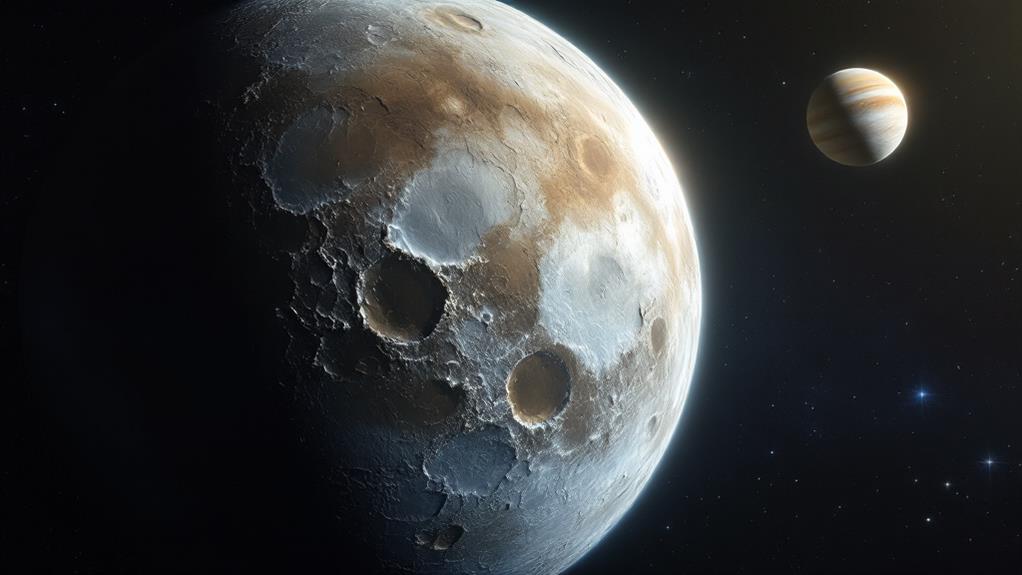
Jupiter's colossal moon Ganymede stands out as the largest in our solar system. It's even bigger than the planet Mercury, with a diameter of 5,268 kilometers. You'd be amazed to know that Ganymede is the only moon known to have its own magnetic field, which interacts with Jupiter's massive magnetosphere.
Beneath Ganymede's icy surface lies a hidden treasure: a subsurface ocean. Scientists believe this ocean contains more water than all of Earth's oceans combined. The moon's unique structure consists of an iron core surrounded by a rocky mantle and a thick ice shell.
Ganymede's surface is a patchwork of dark and light regions, with numerous impact craters and long, winding grooves. These features suggest a complex geological history. The moon's tenuous atmosphere, composed mainly of oxygen, adds another layer of intrigue to its already fascinating characteristics.
As you venture into Ganymede's mysteries, you'll uncover that it's not just size that makes this moon extraordinary. Its unique magnetic field, hidden ocean, and diverse surface features make it a prime target for future investigation and the search for potential habitable environments beyond Earth.
Phobos: Mars' Doomed Companion
While many moons in our solar system are relatively stable, Mars' innermost moon Phobos is on a collision course with its parent planet. This small, potato-shaped satellite is slowly spiraling towards Mars due to powerful tidal forces. Scientists estimate that in about 50 million years, Phobos will either crash into Mars or be torn apart by gravitational stress, potentially forming a ring around the planet.
Phobos' mysterious origin has puzzled astronomers for decades. Some theories suggest it's a captured asteroid, while others propose it formed from debris ejected during a massive impact on Mars. Its surface is covered in strange grooves, which may be stress fractures caused by Mars' gravitational pull.
You'd find walking on Phobos a peculiar experience. Its gravity is so weak that you could easily jump off its surface. At just 22.2 kilometers in diameter, Phobos is one of the smallest moons in our solar system. Despite its diminutive size, this doomed moon continues to fascinate scientists as they race to decipher its secrets before its inevitable demise.
Triton's Retrograde Orbit
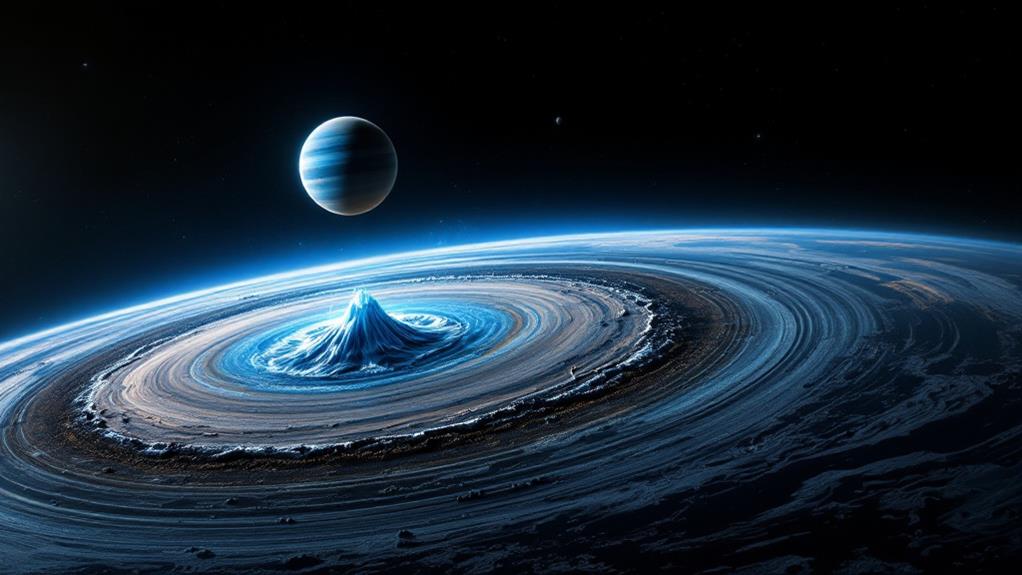
Neptune's largest moon Triton stands out as one of the solar system's most peculiar satellites due to its retrograde orbit. Unlike most moons, Triton orbits in the opposite direction of its planet's rotation. This unique characteristic has puzzled scientists for decades and sparked numerous theories about its origin and fate.
The retrograde orbit formation of Triton likely occurred through a capture event, rather than forming alongside Neptune. Scientists believe that Triton was once a dwarf planet from the Kuiper Belt that ventured too close to Neptune's gravitational pull. This encounter resulted in Triton's capture and the establishment of its unusual orbit.
The retrograde orbit implications for Triton are significant:
- Tidal forces are gradually pulling Triton closer to Neptune
- The moon's orbit is becoming more circular over time
- Triton may eventually break apart or crash into Neptune
As you observe Triton's peculiar motion, you're witnessing a cosmic dance that's slowly coming to an end. This moon's unique orbit provides informative observations into the changing nature of our solar system and the complex interactions between planets and their satellites.
Charon: Pluto's Massive Moon
Pluto's largest moon, Charon, is a celestial oddity that's nearly half the size of its parent dwarf planet. This unique size ratio creates a fascinating gravitational dance between the two bodies. Unlike most moons in our solar system, Charon doesn't orbit around Pluto's center. Instead, they orbit around a shared center of mass located outside Pluto's surface.
You'll find that Charon's tidal locking with Pluto creates an even more intriguing situation. Both Pluto and Charon always show the same face to each other, locked in an eternal connection. This synchronous rotation means that if you were standing on Pluto's surface facing Charon, you'd see the moon hanging motionless in the sky.
Charon's composition is primarily water ice and rock, much like Pluto itself. Its surface features large chasms, suggesting a history of geological activity. Despite its small size, Charon boasts a diverse terrain with mountains, valleys, and plains. Scientists believe that an ancient subsurface ocean may have once existed beneath Charon's icy crust, potentially harboring conditions suitable for primitive life forms.
Miranda's Patchwork Terrain
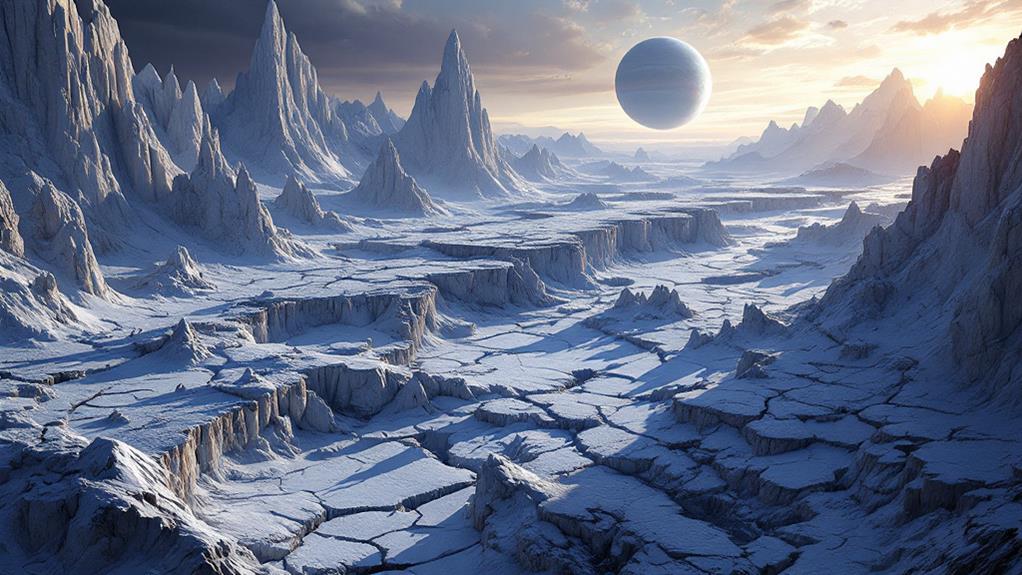
Shifting our gaze from Pluto's moon to Uranus' celestial companion, we encounter Miranda, a moon with a truly bizarre appearance. This small moon's surface is a patchwork of varied terrains, making it one of the most peculiar objects in our solar system. Miranda's unusual surface features have puzzled scientists since its observation by Voyager 2 in 1986.
You'll find Miranda's scenery to be a mishmash of contrasting regions, including:
- Coronae: Large, oval-shaped areas with concentric bands and ridges
- Chasms: Deep canyons that can reach depths of up to 12 miles
- Cliffs: Towering vertical drops, some as high as 12 miles
These dramatic features suggest a history of intense tectonic activity on Miranda. Scientists believe the moon may have been shattered and reassembled multiple times in its past, leading to its current jumbled appearance. Alternatively, some theorize that Miranda's interior may have partially melted and refrozen, causing its surface to deform and create the patchwork terrain we see today. Whatever the cause, Miranda's unique surface continues to intrigue planetary scientists and offers a fascinating glimpse into the diverse landscapes found on moons throughout our solar system.
Moons as Potential Life Habitats
As we venture beyond our own planet in search of potential extraterrestrial life, moons have emerged as surprisingly promising candidates. Several moons in our solar system harbor subsurface oceans, which scientists believe could potentially support microbial life.
Jupiter's moon Europa is a prime example. Its icy surface conceals a vast ocean that may contain twice as much water as all of Earth's oceans combined. Enceladus, one of Saturn's moons, also boasts a subsurface ocean and even shoots plumes of water vapor into space through cracks in its icy crust.
You might be surprised to learn that Titan, Saturn's largest moon, has a thick atmosphere and liquid methane lakes on its surface. While not water-based, these features make Titan an intriguing target for studying potential alternative forms of life.
Even distant Pluto's moon Charon might have once hosted a subsurface ocean. As we continue to investigate these celestial bodies, we're uncovering that the potential for microbial life may be more widespread in our solar system than we initially thought.
